Seok-Hwan Park
SIM-Enabled Hybrid Digital-Wave Beamforming for Fronthaul-Constrained Cell-Free Massive MIMO Systems
Jun 23, 2025Abstract:As the dense deployment of access points (APs) in cell-free massive multiple-input multiple-output (CF-mMIMO) systems presents significant challenges, per-AP coverage can be expanded using large-scale antenna arrays (LAAs). However, this approach incurs high implementation costs and substantial fronthaul demands due to the need for dedicated RF chains for all antennas. To address these challenges, we propose a hybrid beamforming framework that integrates wave-domain beamforming via stacked intelligent metasurfaces (SIM) with conventional digital processing. By dynamically manipulating electromagnetic waves, SIM-equipped APs enhance beamforming gains while significantly reducing RF chain requirements. We formulate a joint optimization problem for digital and wave-domain beamforming along with fronthaul compression to maximize the weighted sum-rate for both uplink and downlink transmission under finite-capacity fronthaul constraints. Given the high dimensionality and non-convexity of the problem, we develop alternating optimization-based algorithms that iteratively optimize digital and wave-domain variables. Numerical results demonstrate that the proposed hybrid schemes outperform conventional hybrid schemes, that rely on randomly set wave-domain beamformers or restrict digital beamforming to simple power control. Moreover, the proposed scheme employing sufficiently deep SIMs achieves near fully-digital performance with fewer RF chains in most simulated cases, except in the downlink at low signal-to-noise ratios.
Sequential In-Network Processing for Cell-Free Massive MIMO with Capacity-Constrained Parallel Radio Stripes
Dec 10, 2024Abstract:To ensure coherent signal processing across distributed Access Points (APs) in Cell-Free Massive Multiple-Input Multiple-Output (CF-mMIMO) systems, a fronthaul connection between the APs and a Central Processor (CP) is imperative. We consider a fronthaul network employing parallel radio stripes. In this system, APs are grouped into multiple segments where APs within each segment are sequentially connected through a radio stripe. This fronthaul topology strikes a balance between standard star and bus topologies, which deploy parallel or serial connections of all APs. Our focus lies in designing the uplink signal processing for a CF-mMIMO system with parallel radio stripes. We tackle the challenge of finite-capacity fronthaul links by addressing the design of In-Network Processing (INP) strategies at APs. These strategies involve linearly combining received signals and compressing the combining output for fronthaul transmission, aiming to maximize the sum-rate performance. Given the high complexity and the stringent requirement for global Channel State Information (CSI) in jointly optimizing INP strategies across all APs, we propose an efficient sequential design approach. Numerical results demonstrate that the proposed sequential INP design achieves a sum-rate gain of up to 82.92% compared to baseline schemes.
Accelerating Multi-UAV Collaborative Sensing Data Collection: A Hybrid TDMA-NOMA-Cooperative Transmission in Cell-Free MIMO Networks
Nov 04, 2024Abstract:This work investigates a collaborative sensing and data collection system in which multiple unmanned aerial vehicles (UAVs) sense an area of interest and transmit images to a cloud server (CS) for processing. To accelerate the completion of sensing missions, including data transmission, the sensing task is divided into individual private sensing tasks for each UAV and a common sensing task that is executed by all UAVs to enable cooperative transmission. Unlike existing studies, we explore the use of an advanced cell-free multiple-input multiple-output (MIMO) network, which effectively manages inter-UAV interference. To further optimize wireless channel utilization, we propose a hybrid transmission strategy that combines time-division multiple access (TDMA), non-orthogonal multiple access (NOMA), and cooperative transmission. The problem of jointly optimizing task splitting ratios and the hybrid TDMA-NOMA-cooperative transmission strategy is formulated with the objective of minimizing mission completion time. Extensive numerical results demonstrate the effectiveness of the proposed task allocation and hybrid transmission scheme in accelerating the completion of sensing missions.
Generalized Reduced-WMMSE Approach for Cell-Free Massive MIMO With Per-AP Power Constraints
Aug 02, 2024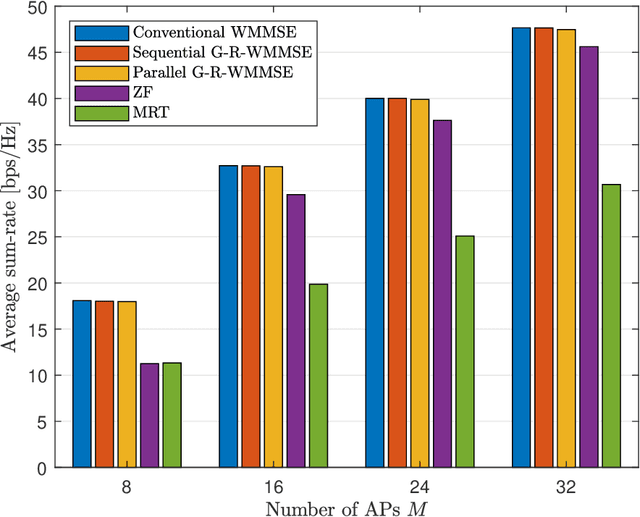
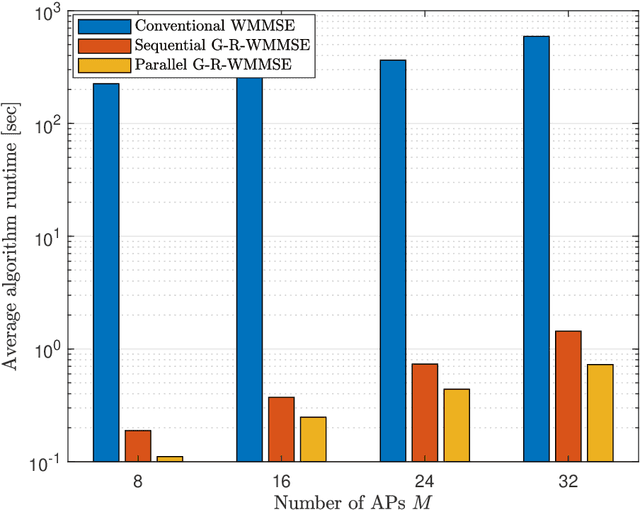
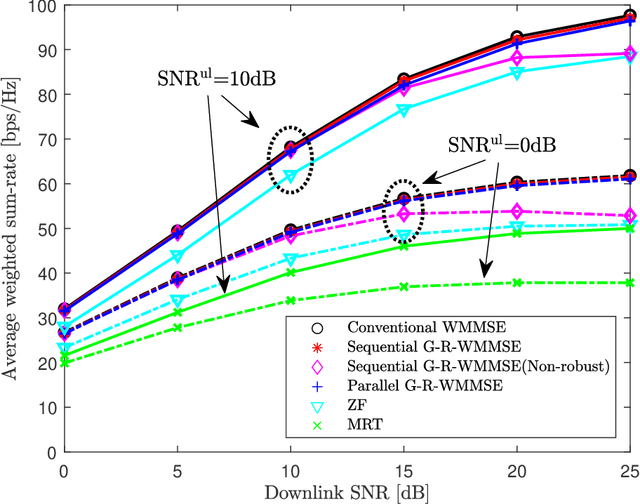
Abstract:The optimization of cooperative beamforming vectors in cell-free massive MIMO (mMIMO) systems is presented where multi-antenna access points (APs) support downlink data transmission of multiple users. Albeit the successes of the weighted minimum mean squared error (WMMSE) algorithm and their variants, they lack careful investigations about computational complexity that scales with the number of antennas and APs. We propose a generalized and reduced WMMSE (G-R-WMMSE) approach whose complexity is significantly lower than conventional WMMSE. We partition the set of beamforming coefficients into subvectors, with each subvector corresponding to a specific AP. Such a partitioning approach decomposes the original WMMSE problem across individual APs. By leveraging the Lagrange duality analysis, a closed-form solution can be derived for each subproblem, which substantially reduces the computation burden. Additionally, we present a parallel execution of the proposed G-R-WMMSE with adaptive step sizes, aiming at further reducing the time complexity. Numerical results validate that the proposed G-R-WMMSE schemes achieve over 99% complexity savings compared to the conventional WMMSE scheme while maintaining almost the same performance.
Joint Precoding and Fronthaul Compression for Cell-Free MIMO Downlink With Radio Stripes
Aug 07, 2023



Abstract:A sequential fronthaul network, referred to as radio stripes, is a promising fronthaul topology of cell-free MIMO systems. In this setup, a single cable suffices to connect access points (APs) to a central processor (CP). Thus, radio stripes are more effective than conventional star fronthaul topology which requires dedicated cables for each of APs. Most of works on radio stripes focused on the uplink communication or downlink energy transfer. This work tackles the design of the downlink data transmission for the first time. The CP sends compressed information of linearly precoded signals to the APs on fronthaul. Due to the serial transfer on radio stripes, each AP has an access to all the compressed blocks which pass through it. Thus, an advanced compression technique, called Wyner-Ziv (WZ) compression, can be applied in which each AP decompresses all the received blocks to exploit them for the reconstruction of its desired precoded signal as side information. The problem of maximizing the sum-rate is tackled under the standard point-to-point (P2P) and WZ compression strategies. Numerical results validate the performance gains of the proposed scheme.
Rate-Splitting Multiple Access for 6G Networks: Ten Promising Scenarios and Applications
Jun 22, 2023Abstract:In the upcoming 6G era, multiple access (MA) will play an essential role in achieving high throughput performances required in a wide range of wireless applications. Since MA and interference management are closely related issues, the conventional MA techniques are limited in that they cannot provide near-optimal performance in universal interference regimes. Recently, rate-splitting multiple access (RSMA) has been gaining much attention. RSMA splits an individual message into two parts: a common part, decodable by every user, and a private part, decodable only by the intended user. Each user first decodes the common message and then decodes its private message by applying successive interference cancellation (SIC). By doing so, RSMA not only embraces the existing MA techniques as special cases but also provides significant performance gains by efficiently mitigating inter-user interference in a broad range of interference regimes. In this article, we first present the theoretical foundation of RSMA. Subsequently, we put forth four key benefits of RSMA: spectral efficiency, robustness, scalability, and flexibility. Upon this, we describe how RSMA can enable ten promising scenarios and applications along with future research directions to pave the way for 6G.
Learning Decentralized Power Control in Cell-Free Massive MIMO Networks
Mar 05, 2023Abstract:This paper studies learning-based decentralized power control methods for cell-free massive multiple-input multiple-output (MIMO) systems where a central processor (CP) controls access points (APs) through fronthaul coordination. To determine the transmission policy of distributed APs, it is essential to develop a network-wide collaborative optimization mechanism. To address this challenge, we design a cooperative learning (CL) framework which manages computation and coordination strategies of the CP and APs using dedicated deep neural network (DNN) modules. To build a versatile learning structure, the proposed CL is carefully designed such that its forward pass calculations are independent of the number of APs. To this end, we adopt a parameter reuse concept which installs an identical DNN module at all APs. Consequently, the proposed CL trained at a particular configuration can be readily applied to arbitrary AP populations. Numerical results validate the advantages of the proposed CL over conventional non-cooperative approaches.
A Bipartite Graph Neural Network Approach for Scalable Beamforming Optimization
Jul 12, 2022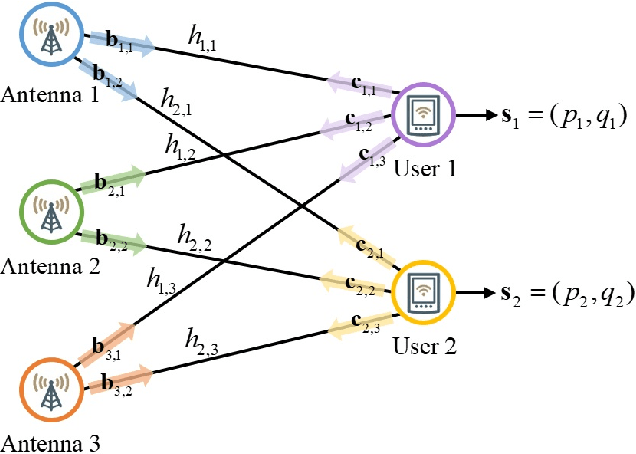

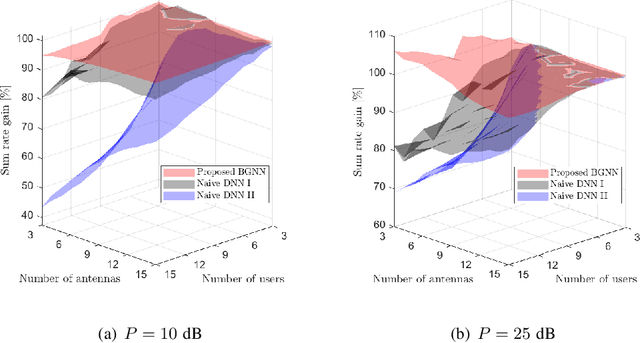
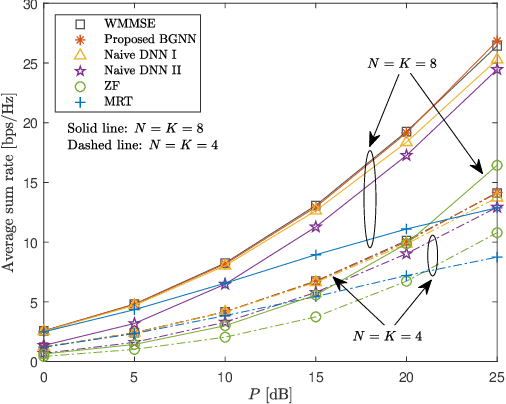
Abstract:Deep learning (DL) techniques have been intensively studied for the optimization of multi-user multiple-input single-output (MU-MISO) downlink systems owing to the capability of handling nonconvex formulations. However, the fixed computation structure of existing deep neural networks (DNNs) lacks flexibility with respect to the system size, i.e., the number of antennas or users. This paper develops a bipartite graph neural network (BGNN) framework, a scalable DL solution designed for multi-antenna beamforming optimization. The MU-MISO system is first characterized by a bipartite graph where two disjoint vertex sets, each of which consists of transmit antennas and users, are connected via pairwise edges. These vertex interconnection states are modeled by channel fading coefficients. Thus, a generic beamforming optimization process is interpreted as a computation task over a weight bipartite graph. This approach partitions the beamforming optimization procedure into multiple suboperations dedicated to individual antenna vertices and user vertices. Separated vertex operations lead to scalable beamforming calculations that are invariant to the system size. The vertex operations are realized by a group of DNN modules that collectively form the BGNN architecture. Identical DNNs are reused at all antennas and users so that the resultant learning structure becomes flexible to the network size. Component DNNs of the BGNN are trained jointly over numerous MU-MISO configurations with randomly varying network sizes. As a result, the trained BGNN can be universally applied to arbitrary MU-MISO systems. Numerical results validate the advantages of the BGNN framework over conventional methods.
Completion Time Minimization of Fog-RAN-Assisted Federated Learning With Rate-Splitting Transmission
Jun 03, 2022



Abstract:This work studies federated learning (FL) over a fog radio access network, in which multiple internet-of-things (IoT) devices cooperatively learn a shared machine learning model by communicating with a cloud server (CS) through distributed access points (APs). Under the assumption that the fronthaul links connecting APs to CS have finite capacity, a rate-splitting transmission at IoT devices (IDs) is proposed which enables hybrid edge and cloud decoding of split uplink messages. The problem of completion time minimization for FL is tackled by optimizing the rate-splitting transmission and fronthaul quantization strategies along with training hyperparameters such as precision and iteration numbers. Numerical results show that the proposed rate-splitting transmission achieves notable gains over benchmark schemes which rely solely on edge or cloud decoding.
Robust Design of Rate-Splitting Multiple Access With Imperfect CSI for Cell-Free MIMO Systems
Mar 07, 2022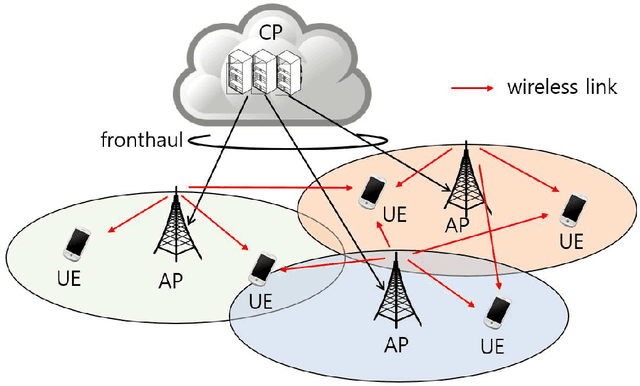
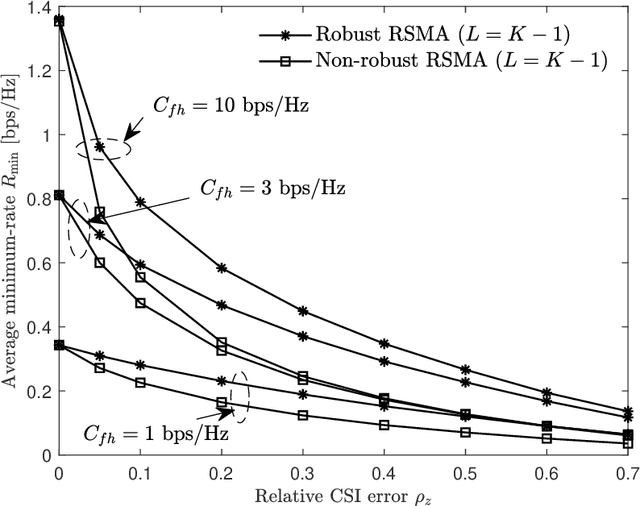
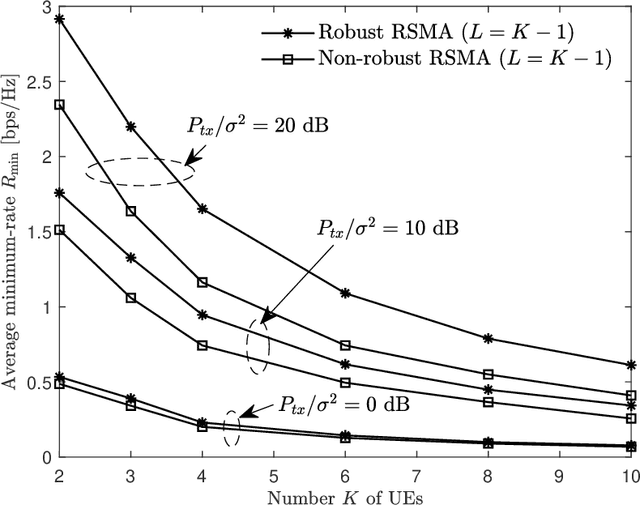
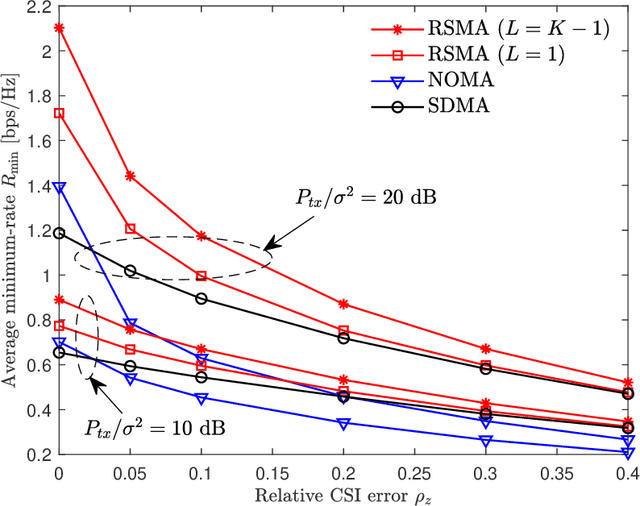
Abstract:Rate-Splitting Multiple Access (RSMA) for multi-user downlink operates by splitting the message for each user equipment (UE) into a private message and a set of common messages, which are simultaneously transmitted by means of superposition coding. The RSMA scheme can enhance throughput and connectivity as compared to conventional multiple access techniques by optimizing the rate-splitting ratios along with the corresponding downlink beamforming vectors. This work examines the impact of erroneous channel state information (CSI) on the performance of RSMA in cell-free multiple-input multiple-output (MIMO) systems. An efficient robust optimization algorithm is proposed by using closed-form lower bound expressions on the expected data rates. Extensive numerical results show the importance of robust design in the presence of CSI errors and how the performance gain of RSMA over conventional schemes is affected by CSI imperfection.
 Add to Chrome
Add to Chrome Add to Firefox
Add to Firefox Add to Edge
Add to Edge